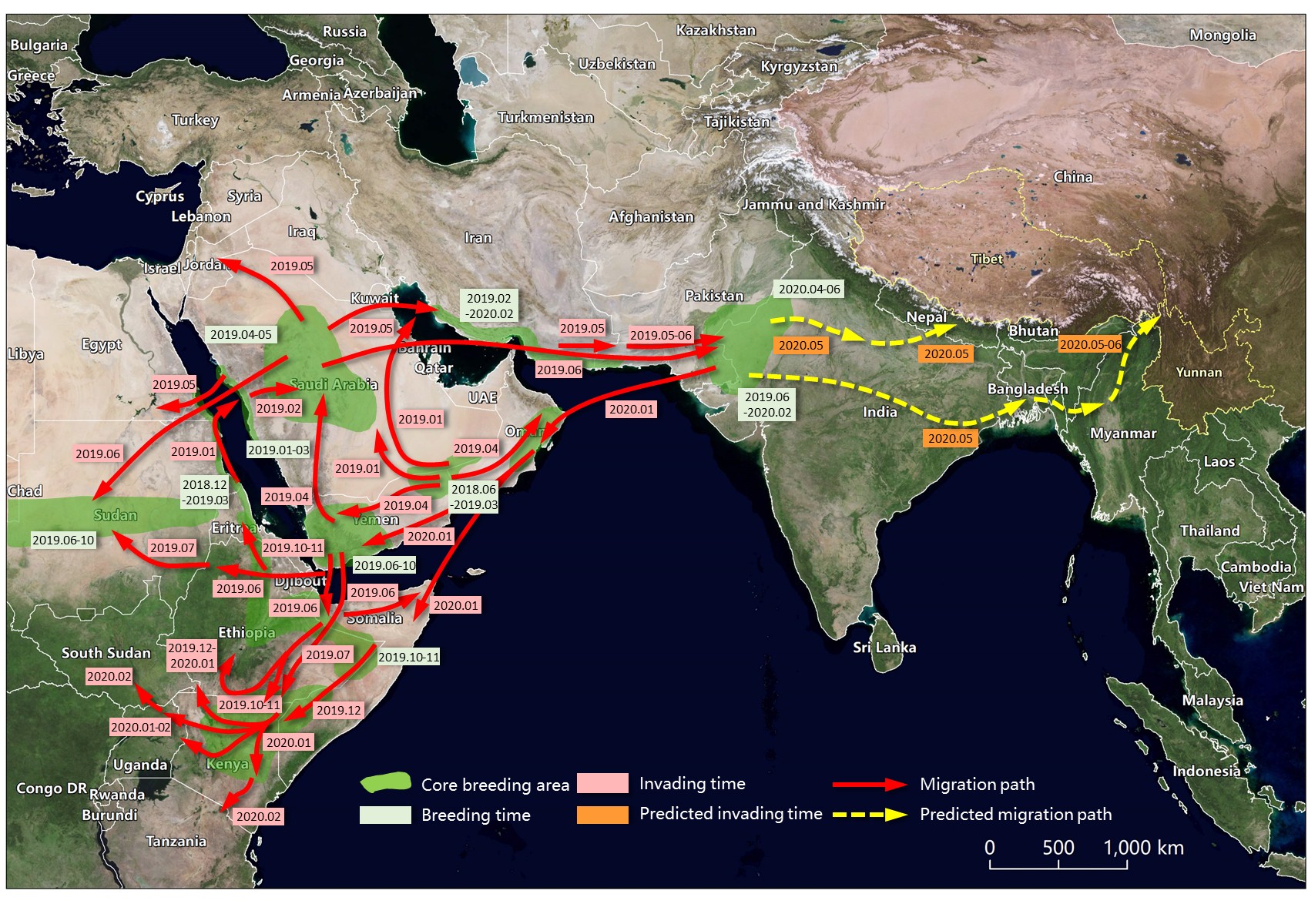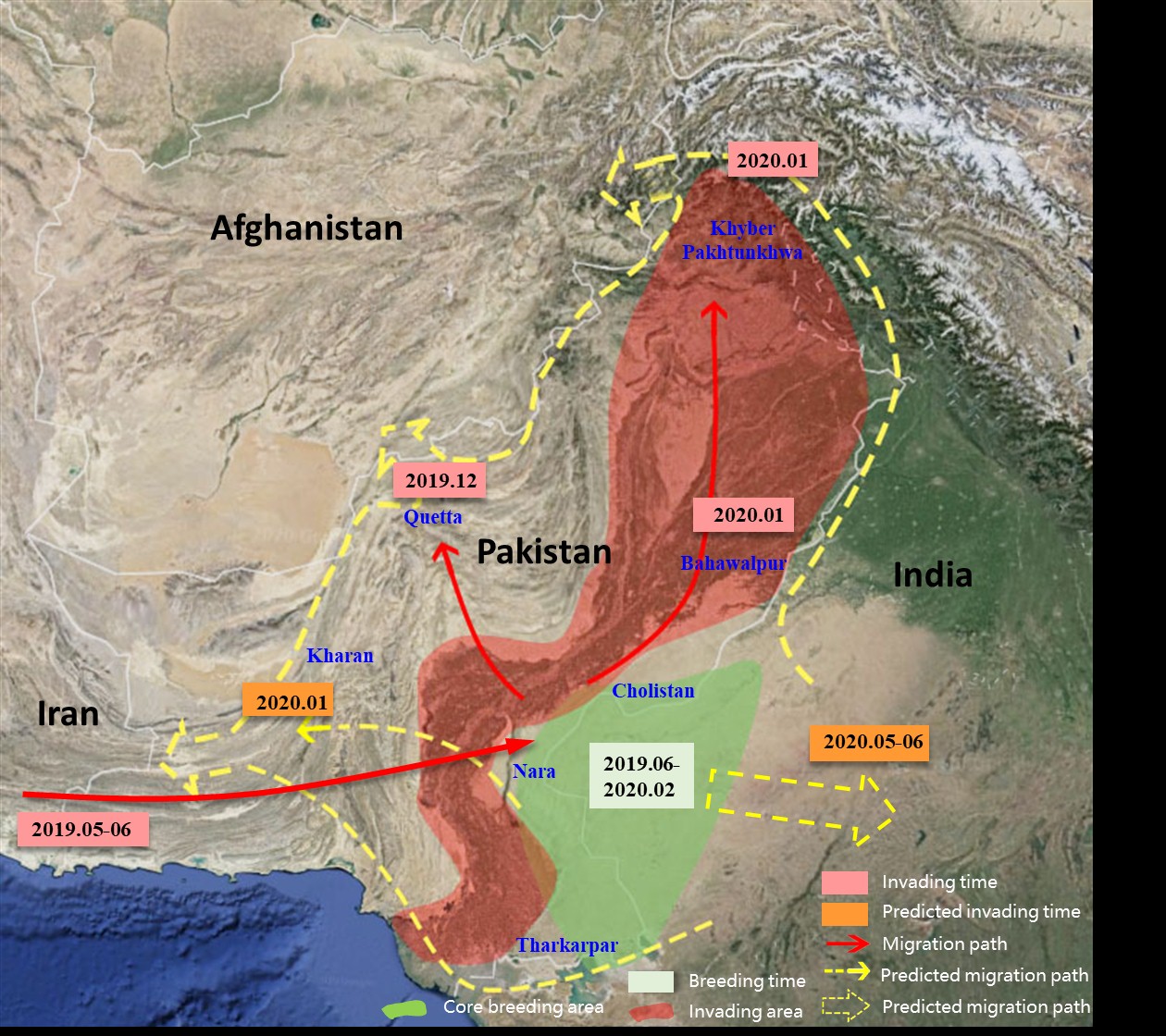
News
CAS Scientists Assess Risk of Desert Locust Invasion China, Based on Remote Sensing Monitoring
Date:2020-02-26
The Desert Locust has ravaged the Horn of Africa and Southwest Asia, posing serious threats on agricultural production and food security of the inflicted regions. The Food and Agriculture Organization of the United nations (FAO) has issued a worldwide Desert Locust warning, calling for joint efforts from multiple countries in prevention and control of the pest to ensure food security and regional stability.
A research team led by Prof. HUANG Wenjiang and Dr. DONG Yingying from the Aerospace Information Research Institute (AIR) under the Chinese Academy of Sciences (CAS) has tracked the migration path of the Desert Locust and make a detailed analysis on the possibility of the Desert Locust invasion of China.
The research combines multi-source Earth Observation data (including GF series in China, MODIS and Landsat series in US, and Sentinel series in EU), meteorological data, field data, and self-developed models and algorithms for Desert Locust monitoring and forecasting based on the Digital Earth Science Platform developed by AIR.
Fig.1 shows the migration path of the Desert Locust from Year 2018 to 2020. Due to the influence of Northeast Monsoon and the barrier of Qinghai-Tibetan Plateau, it has a lower probability of the Desert Locust in the Indo-Pakistan border invading China at present, according to the analysis. However, if the locust in Pakistan and India cannot be controlled effectively, and even disasters erupt, then when the Southwest Monsoon is extremely strong, it may has a higher probability for the locust moving from India to Myanmar via Bangladesh, and higher risk to invade China's Yunnan and Tibet from May to June 2020, according to the analysis.

Fig.1. Migration path of Desert Locust (Year 2018-2020).
Fig. 2 shows the time series remote sensing monitoring results. From October to December 2019, the locust swarms at the Indo-Pakistan border began to breed in three generations and migrated to spring breeding areas of southern Iran and northern Oman via Baluchistan. From January to February 2020, locust swarms existed in northwest Pakistan, Nara, Tharparkar, and Cholistan. Some of them moved north of Bahawalpur, and some had the trend of migration to southwest Pakistan and southern Iran due to climate impact.

Fig.2. Time series remote sensing monitoring of Desert Locust damaged area in Pakistan from Year 2019 – 2020.
Before May 2020, affected by the Northeast Monsoon, there are three potential migration paths of locusts along the Indo-Pakistan border, which are Indo-Pakistan border-Bahawalpur-Khyber Pakhtunkhwa, Indo-Pakistan border-Quetta and southern Region, Indo-Pakistan border-southwestern Baluchistan, shown in Fig.3.

Fig.3. Migration path of Desert Locust in Pakistan from Year 2019–2020.
Scientists warn that, if the Desert Locusts in Pakistan are not effectively controlled in the adult stage in May 2020, the locust plague will continue to outbreak, which may cause a severe blow to Pakistan’s agricultural production. In addition, although the Indian locust plague has been controlled to a certain extent, affected by the southwest monsoon from May to June, locusts on the Indo-Pakistan border may migrate from Pakistan to India, continue to invade Nepal, Bangladesh, Myanmar, and may a higher risk to invade China’s Yunnan and Tibet. Considering China's biodiversity, climate and other conditions are conducive to further breeding and migration of locusts, coupled with the local Migratory Locust, one of the main pests in China, it will bring serious threats to China’s food security.
Scientists suggested the government to carry out large-scale locust disaster monitoring and early warning, while boosting global cooperation on Desert Locust prevention to help ensure global food security.
The research is supported by Strategic Priority Research Program of the Chinese Academy of Sciences (XDA19080000), National Key R&D Program of China (2016YFB0501501), National Key R&D Program of China (2017YFE0122400) etc.



